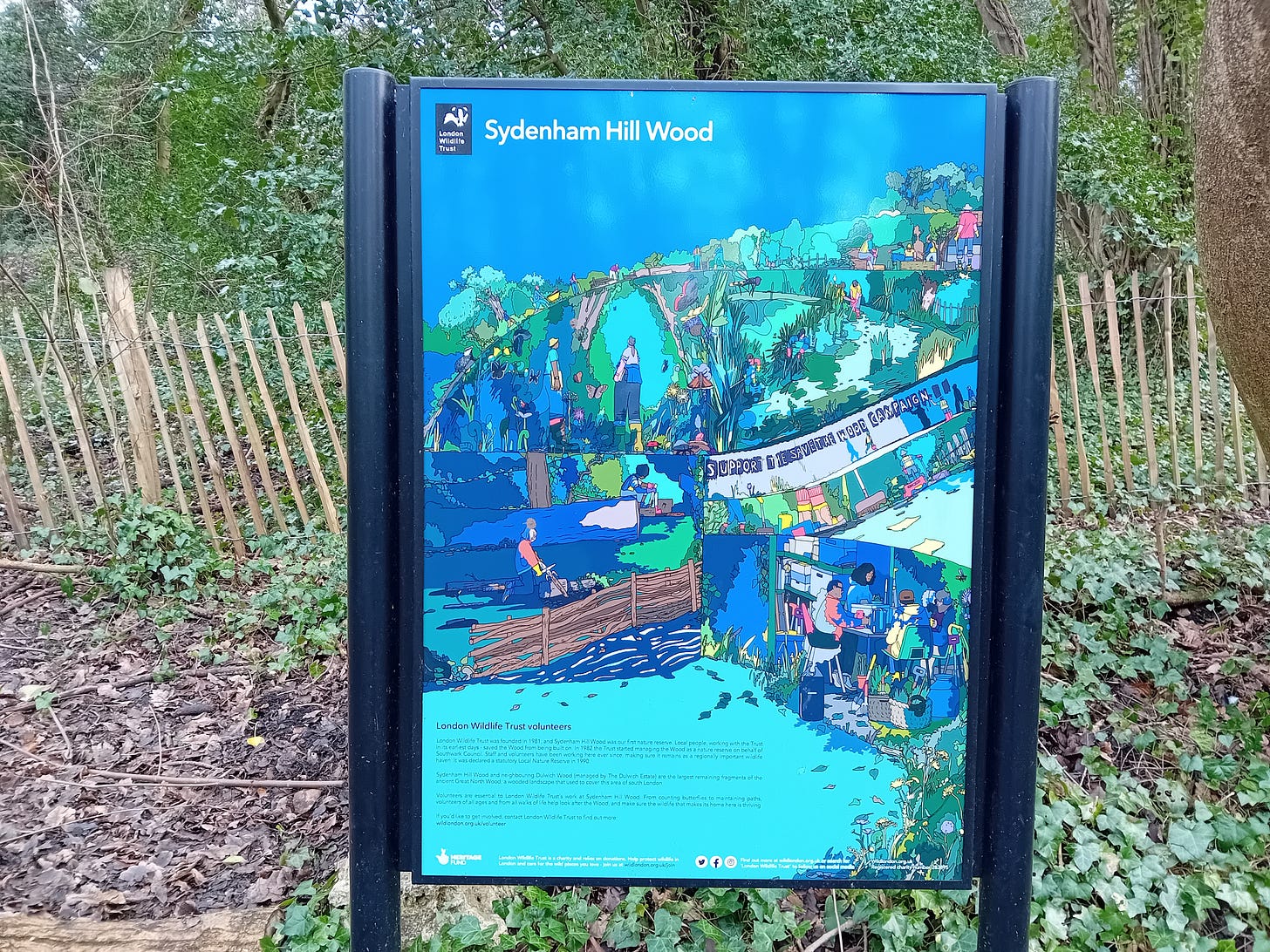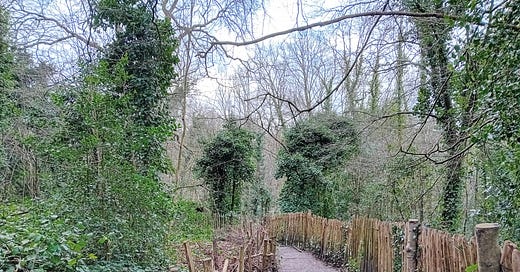Homes for all
Some thoughts on how we can provide more homes for humans without destroying the homes of other species
If you’re interested in doing some writing with me, there are details at the end of this post for a workshop I’m running in a few weeks time
Shafts of sunlight shine down on us between gaps in the trees and the green shoots of bluebells are starting to emerge from the earth. It’s early February and there’s a sense that Spring is not too far away now. After a very busy couple of weeks at work when I haven’t been able to do any conservation volunteering it’s good to spend a day enclosed within the trees once more.
Today I’m in Sydenham Hill Wood, which together with neighbouring Dulwich Wood is the largest remaining section of the Great North Wood, a huge woodland that once stretched across most of this part of South London. You can read more about the Great North Wood in this piece I wrote a year ago.
Sydenham Hill Wood has also played a significant role in the more recent history of London’s wilder places. When Southwark Council proposed building housing here in the 1980s, it was a campaign to save this ancient woodland from development which led to it becoming London Wildlife Trust’s first nature reserve in 1982. Now the wood is home to numerous wildlife species including more than 200 species of trees and plants and rare fungi. It is also visited by hundreds of thousands of people every year.
Whenever I visit, I find it hard to believe I’m only a few miles from the centre of London. Today, I find myself thinking too of how Sydenham Hill wood only exists because local people campaigned to protect it for nature. It is a timely reminder of just how important it is to have strong protections for the natural environment, something our current Government seems intent on removing in their pursuit of growth at any cost, and their determination to meet ambitious housing targets.
Few would dispute that we need to provide many more new homes in Britain, but there is little agreement about the cause of the housing crisis. Local authorities are often blamed for taking too long to approve planning applications for new housing but analysis published last year identified that one in three of the homes granted planning permission in England and Wales since 2015 had not yet been built, a total of 1.2 million homes.
According to CPRE, the Countryside Charity, this huge number of unimplemented planning permissions is part of the business strategies of the large house building companies. Limiting the supply of new housing for sale helps secure the maximum price for each unit and thus generates more profit for the companies’ shareholders. It’s easy for them to operate in this way because there is currently little pressure on developers to go ahead with a development if it is not in their interests to do so. A full planning permission usually lasts for three years, and developers can claim to have implemented the permission by carrying out some relatively minor works but then pause work indefinitely.
The housebuilders adopt other tactics to ensure the success of this approach including holding on to large amounts of land to prevent sites being developed by other companies who might build housing more quickly - a practice known as land-banking. The Government has recently committed to addressing some of these issues including giving local planning authorities the power to refuse further applications from developers who have failed to complete previous housing developments in their area at a reasonable rate. Whether this will be sufficient to address land-banking remains to be seen.
But is more development really the only answer anyway? What about all those homes that have already been built but remain empty? Local authorities can now charge additional council tax – known as a premium - on property that has been left empty and unfurnished for a certain amount of time. This premium - which can be as much as four times the normal rate where properties have been empty for 10 or more years - is intended to incentivise owners to bring empty properties back into use, but it doesn’t appear to be having the intended effect.
Official figures show that the number of long-term empty homes in England rose by 4000 to 265,061 in 2024. In Southwark, the borough that contains Sydenham Hill Woods, there were 2,384 empty homes in 2024, a decrease from the 2,920 in 2023, but this was offset by a rise in the number of second homes. As a result, 1 in every 27 homes in the borough is not in residential use on a long-term basis.
Bringing empty homes back into use would not only ease the pressure on green spaces, but it would also help reduce the climate impacts of construction as there would be less need for concrete, steel and other materials. It should be at the heart of plans to solve the housing crisis but it is not even mentioned in the current strategic plan for Homes England, the government’s housing and regeneration agency.

Another issue is the “buy-to-leave” investors who buy new properties they have no intention of living in or even renting out. Action on Empty Homes (AEH) believe this is only one part of a much wider problem of what they call the “financialisation” distorting the London property market. In 2020 AEH calculated that the true figure for the number of empty homes in London should be nearly five times the official figure, once you include all the homes which are significantly underutilised, such as second homes and short-term let investments.
As so few of the properties built are going to those who need a home and most of the new properties are unaffordable to ordinary Londoners, many of those on lower incomes are reliant on the social housing provided by housing associations or directly by local authorities. However, in 2021, the homelessness charity, Shelter, calculated that there was a net loss of nearly half a million social homes in England in the previous 20 years as a result of “right-to-buy” sales and estate regeneration programmes.
The Government has recently proposed changes to the eligibility criteria which should significantly reduce the number of social homes lost to “right-to-buy” in future. But cash-strapped local authorities still have social housing targets to deliver and with little prospect of buying up new sites on the open market, they are trying to maximise the potential opportunities for building on land they already own. This means that even small pockets of open space on existing housing estates are under threat. Not surprisingly, these infill proposals often prove to be very controversial particularly when they involve the loss of open space in areas where residents have little or no access to private outdoor space.
The debate about such proposals often focuses almost entirely on the impacts for the city’s human population and the choice between retaining recreational space and delivering new homes. But, of course, there are lots of other species who rely on these spaces too, species whose lives are increasingly under threat and which we should be doing everything in our power to help protect. Many mobile species, such as bats, rely on several different sites and/or habitats during their lifecycles so the loss of even small pockets of open space can have wider implications for wildlife in the surrounding area, particularly where those spaces help provide a link between other larger sites nearby. Unfortunately, the planning system does not always recognise the importance for wildlife of small pockets of green space on housing estates.
There clearly isn’t a simple answer to any of this, but at a time when we face a nature and climate crisis as well as a housing one we really do need to put more emphasis on measures such as bringing empty homes back into use so we can provide many more new homes for humans without losing more and more land to development, and destroying the homes of other species in the process.
To finish….
…a few things I’d like to share:
To finish:
1. Nearby Nature - A Creative Writing Workshop: On Saturday 1 March, I’m running a writing workshop at One Tree Hill. This will be a relaxed and informal opportunity to discuss short pieces of urban nature writing and have a go at doing some writing of your own. If the weather is good enough, we’ll also get outside to experience some of the nearby nature too. You can book a place here.
2. Kyoto: If you’re in London, I’d highly recommend going to see this play which dramatises the events that led up to the negotiations for the Kyoto Protocol in 1997, highlighting just how much effort the major oil producers put into trying to sabotage climate talks over the years. There was a discussion about the play on BBC Radio 4’s Start the Week recently.
3. Raising Hare by Chloe Dalton: I haven’t actually read this book yet but a friend recommended it to me when it was Book of the Week on Radio 4 a few weeks ago and I really enjoyed listening to it. It’s a fascinating account of how the author raised a leveret that she found abandoned while out walking and how the two developed a very close bond even after the hare reached adulthood and had leverets of its own. The Book of the Week podcast is no longer available but you can listen to an interview with Chloe Dalton on this podcast.






Thanks for brilliant article, bringing so much information together. Why oh why don't the politicians grasp the importance of saving Nature, of the waste of space etc of empty homes, waste of concrete etc building new homes when there's so much vacant housing stock?!
Partly because they're allowing the big housing contractors to carry on prioritising profit profit profit!